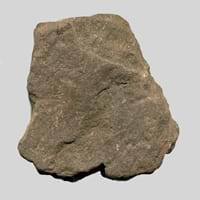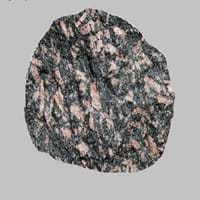Definition
Shale is a fine-grained sedimentary rock which is formed by the compaction of silt and clay-size mineral particles
Luxullianite is a rare type of granite, known for presence of clusters of radially arranged acicular tourmaline crystals which are enclosed by phenocrysts of orthoclase and quartz in a matrix of quartz, tourmaline, alkali feldspar, brown mica.
Discoverer
Unknown
Unknown
Etymology
From German Schalstein laminated limestone, and Schalgebirge layer of stone in stratified rock. From Old English scealu in its base sense of- thing that divides or separate,
From the village of Luxulyan in Cornwall, England, where this variety of granite is found
Class
Sedimentary Rocks
Igneous Rocks
Sub-Class
Durable Rock, Medium Hardness Rock
Durable Rock, Hard Rock
Group
Not Applicable
Plutonic
Other Categories
Fine Grained Rock, Opaque Rock
Coarse Grained Rock, Opaque Rock
Texture
Clastic, Splintery
Granular, Phaneritic
Color
Black, Brown, Buff, Green, Grey, Red, Yellow
Black, Grey, Orange, Pink, White
Durability
Durable
Durable
Appearance
Muddy
Veined or Pebbled
Interior Uses
Decorative Aggregates, Homes, Interior Decoration
Bathrooms, Countertops, Decorative Aggregates, Entryways, Floor Tiles, Homes, Hotels, Interior Decoration, Kitchens, Stair Treads
Exterior Uses
As Building Stone, As Facing Stone, Office Buildings
As Building Stone, As Facing Stone, Paving Stone, Garden Decoration, Office Buildings
Other Architectural Uses
Curbing
Curbing
Construction Industry
Cement Manufacture, Construction Aggregate, for Road Aggregate, Making natural cement, Raw material for the manufacture of mortar
As Dimension Stone
Medical Industry
Not Yet Used
Not Yet Used
Antiquity Uses
Artifacts, Sculpture
Artifacts, Monuments, Sculpture
Commercial Uses
Creating Artwork, Pottery
Creating Artwork, Curling, Gemstone, Laboratory bench tops, Tombstones
Types
Red Shale, Black Shale, Green Shale, Grey Shale and Yellow Shale
Igneous Protolith Granite, Sedimentary Protolith Granite, Mantle Granite, Anorogenic Granite and Hybrid Granite
Features
Easily splits into thin plates, Generally rough to touch, Very fine grained rock
Available in Lots of Colors and Patterns, It is One of the Oldest, Strongest and Hardest Rock
Archaeological Significance
Famous Monuments
Jantar Mantar in India
Data Not Available
Famous Sculptures
Data Not Available
Data Not Available
Pictographs
Used
Not Used
Petroglyphs
Used
Not Used
Formation
Shale forms when very fine-grained clay particles are deposited in water which settle at the bottom of water bodies. They are later compacted hence forming shale.
Luxullianite is an intrusive igneous rock which is very hard, crystalline and is visibly homogeneous in texture. It is found in large plutons on the continents, i.e. in areas where the Earth's crust has been deeply eroded.
Mineral Content
Albite, Biotite, Calcite, Chert, Chlorite, Dolomite, Hematite, Micas, Muscovite or Illite, Pyrite, Quartz, Silica, Sulfides
Amphibole, Biotite, Feldspar, Hornblade, Micas, Muscovite or Illite, Plagioclase, Pyroxene, Quartz
Compound Content
Ca, Fe, Mg, Silicon Dioxide, Sodium
Aluminium Oxide, CaO, Iron(III) Oxide, FeO, Potassium Oxide, MgO, MnO, Sodium Oxide, Phosphorus Pentoxide, Silicon Dioxide, Titanium Dioxide
Types of Metamorphism
Not Applicable
Burial Metamorphism, Cataclastic Metamorphism, Contact Metamorphism, Hydrothermal Metamorphism, Impact Metamorphism
Types of Weathering
Biological Weathering, Chemical Weathering, Mechanical Weathering
Biological Weathering, Chemical Weathering, Mechanical Weathering
Types of Erosion
Chemical Erosion, Coastal Erosion, Glacier Erosion
Chemical Erosion, Water Erosion, Wind Erosion
Grain Size
Very fine-grained
Large and Coarse Grained
Fracture
Not Available
Not Available
Porosity
Highly Porous
Less Porous
Luster
Dull
Dull to Grainy with Sporadic parts Pearly and Vitreous
Cleavage
Slaty
Not Available
Toughness
2.6
Not Available
Specific Gravity
2.2-2.8
2.6-2.7
Transparency
Opaque
Opaque
Density
2.4-2.8 g/cm3
2.6-2.8 g/cm3
Resistance
Heat Resistant, Impact Resistant
Heat Resistant, Wear Resistant
Deposits in Eastern Continents
Asia
Bangladesh, China, India, Russia
China, India, Iran, Saudi Arabia, Sri Lanka, Taiwan, Thailand, Turkey, Vietnam
Africa
Ethiopia, Kenya, Morocco, South Africa, Tanzania
Angola, Egypt, Madagascar, Namibia, Nigeria, South Africa
Europe
Austria, France, Germany, Greece, Italy, Romania, Scotland, Spain, Switzerland
Austria, Belgium, Finland, France, Germany, Italy, Norway, Sardinia, Spain, Switzerland, The Czech Republic, Venezuela
Others
Not Yet Found
Not Yet Found
Deposits in Western Continents
North America
USA
Canada, USA
South America
Bolivia, Chile, Colombia, Ecuador, Peru, Venezuela
Not Yet Found
Deposits in Oceania Continent
Australia
New South Wales, New Zealand, Queensland, Victoria, Western Australia
Not Yet Found










